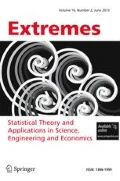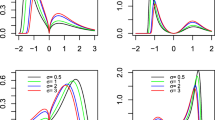Abstract
Estimation of extreme quantile regions, spaces in which future extreme events can occur with a given low probability, even beyond the range of the observed data, is an important task in the analysis of extremes. Existing methods to estimate such regions are available, but do not provide any measures of estimation uncertainty. We develop univariate and bivariate schemes for estimating extreme quantile regions under the Bayesian paradigm that outperforms existing approaches and provides natural measures of quantile region estimate uncertainty. We examine the method’s performance in controlled simulation studies. We illustrate the applicability of the proposed method by analysing high bivariate quantiles for pairs of pollutants, conditionally on different temperature gradations, recorded in Milan, Italy.
Similar content being viewed by others
Change history
17 March 2021
A Correction to this paper has been published: https://doi.org/10.1007/s10687-021-00408-4
References
Antoniano-Villalobos, I., Walker, S.G.: Bayesian nonparametric inference for the power likelihood. J. Comput. Graph. Stat. 22, 801–813 (2013)
Beirlant, J., Goegebeur, Y., Segers, J., Teugels, J.: Statistics of Extremes: Theory and Applications. Wiley, Chichester (2004)
Beranger, B., Padoan, S.A.: Extreme dependence models. In: Extreme Value Modeling and Risk Analysis, pp 325–352. Chapman and Hall/CRC (2015)
Bienvenüe, A., Robert, C.Y.: Likelihood inference for multivariate extreme value distributions whose spectral vectors have known conditional distributions. Scand. J. Stat. 44(1), 130–149 (2017)
Bremnes, J.B.: Probabilistic forecasts of precipitation in terms of quantiles using nwp model output. Mon. Weather. Rev. 132(1), 338–347 (2004a)
Bremnes, J.B.: Probabilistic wind power forecasts using local quantile regression. Wind Energy: An International Journal for Progress and Applications in Wind Power Conversion Technology 7(1), 47–54 (2004b)
Cai, J., Einmahl, J.H.J., de Haan, L.: Estimation of extreme risk regions under multivariate regular variation. Ann. Stat. 39, 1803–1826 (2011)
Cheng, Y., Kan, H.: Effect of the interaction between outdoor air pollution and extreme temperature on daily mortality in Shanghai, China. J. Epidemiol. 22 (1), 28–36 (2012)
Clapp, L.J., Jenkin, M.E.: Analysis of the relationship between ambient levels of o3, no2 and no as a function of nox in the UK. Atmos. Environ. 35(36), 6391–6405 (2001)
Coles, S.G., Pan, F.: The analysis of extreme pollution levels: A case study. J. Appl. Stat. 23, 333–348 (1996)
Cooley, D., Thibaud, E., Castillo, F., Wehner, M.F.: A nonparametric method for producing isolines of bivariate exceedance probabilities. arXiv:1710.05248 (2017)
Dahlhaus, R.: Graphical interaction models for multivariate time series. Metrika 51(2), 157–172 (2000)
de Haan, L., Ferreira, A.: Extreme Value Theory: An Introduction. Springer, New York (2006)
De Sario, M., Katsouyanni, K., Michelozzi, P.: Climate change, extreme weather events, air pollution and respiratory health in Europe. Europ. Resp. J. 42 (3), 826–843 (2013)
Dominici, F., Peng, R.D., Barr, C.D., Bell, M.L.: Protecting human health from air pollution: shifting from a single-pollutant to a multi-pollutant approach. Epidemiology (Cambridge Mass.) 21(2), 187 (2010)
Einmahl, J.H.J., de Haan, L., Krajina, A.: Estimating extreme bivariate quantile regions. Extremes 16, 121–145 (2013)
Falk, M., Padoan, S.A., Wisheckel, F.: Generalized Pareto copulas: A key to multivariate extremes. Journal of Multivariate Analysis. To Appear (2019)
Fan, Y., Sisson, S.A.: Reversible jump Markov chain Monte Carlo. In: Brooks, S.P., Gelman, A., Jones, G., Meng, X.-L., Fan, Y., Sisson, S.A. (eds.) , pp 69–94. Chapman & Hall/CRC (2011)
Friederichs, P., Thorarinsdottir, T.L.: Forecast verification for extreme value distributions with an application to probabilistic peak wind prediction. Environmetrics 23(7), 579–594 (2012)
Garthwaite, P.H., Fan, Y., Sisson, S.A.: Adaptive optimal scaling of Metropolis–Hastings algorithms using the Robbins–Monro process. Commun. Stat.: Theory Methods 45(17), 5098–5111 (2016)
Guerreiro, C., Ortiz, A.G., de Leeuw, F., Viana, M., Horálek, J.: Air quality in Europe – 2016 Report. Publications Office of the European Union (2016)
Haario, H., Saksman, E., Tamminen, J.: An adaptive Metropolis algorithm. Bernoulli 7, 223–242 (2001)
Heffernan, J.E., Tawn, J.A.: A conditional approach for multivariate extreme values. J. R. Stat. Soc. Ser. B Stat. Methodol. 66(3), 497–546 (2004). With discussions and reply by the authors
Huser, R., Davison, A.C., Genton, M.G.: Likelihood estimators for multivariate extremes. Extremes 19(1), 79–103 (2016)
Jagger, T.H., Elsner, J.B.: Modeling tropical cyclone intensity with quantile regression. Int. J. Climatol.: A J. R. Meteorol. Soc. 29(10), 1351–1361 (2009)
Katsouyanni, D.K., Pantazopoulou, A., Touloumi, G., Tselepidaki, I., Moustris, K., Asimakopoulos, D., Poulopoulou, G., Trichopoulos, D.: Evidence for interaction between air pollution and high temperature in the causation of excess mortality. Arch. Environ. Health: Int. J. 48(4), 235–242 (1993). PMID: 8357272
Ledford, A.W., Tawn, J.A.: Statistics for near independence in multivariate extreme values. Biometrika 83, 169–187 (1996)
Marcon, G., Padoan, S.A., Antoniano-Villalobos, I.: Bayesian inference for the extremal dependence. Electron. J. Stat. 10, 3310–3337 (2016)
Marcon, G., Naveau, P., Padoan, S.: A semi-parametric stochastic generator for bivariate extreme events. Statistics 6(1), 184–201 (2017)
Martins, L.D., Wikuats, C.F.H., Capucim, M.N., de Almeida, D.S., da Costa, S.C., Albuquerque, T., Carvalho, V.S.B., de Freitas, E.D., de FÃ!’tima Andrade, M., Martins, J.A.: Extreme value analysis of air pollution data and their comparison between two large urban regions of South America. Weather Clim. Extremes 18, 44–54 (2017)
Naess, A., Karpa, O.: Statistics of extreme wind speeds and wave heights by the bivariate acer method. J. Offshore Mech. Arctic Eng. 137(2), 021602 (2015)
Nikoloulopoulos, A.K., Joe, H., Li, H.: Extreme value properties of multivariate t copulas. Extremes 12(2), 129–148 (2009)
Northrop, P.J., Attalides, N.: Posterior propriety in Bayesian extreme value analyses using reference priors. Stat. Sin. 26(2), 721–743 (2016)
Padoan, S.A., Ribatet, M., Sisson, S.A.: Likelihood-based inference for max-stable processes. J. Am. Stat. Assoc. 105, 263–277 (2010)
Porter, W.C., Heald, C.L., Cooley, D., Russell, B.: Investigating the observed sensitivities of air-quality extremes to meteorological drivers via quantile regression. Atmos. Chem. Phys. 15(18), 10349–10366 (2015)
Prescott, P., Walden, A.: Maximum likeiihood estimation of the parameters of the three-parameter generalized extreme-value distribution from censored samples. J. Stat. Comput. Simul. 16(3-4), 241–250 (1983)
Roberts, G.O., Gelman, A., Gilks, W.R.: Weak convergence and optimal scaling of random walk Metropolis algorithms. Ann. Appl. Probab. 7(1), 110–120 (1997)
Roberts, S.: Interactions between particulate air pollution and temperature in air pollution mortality time series studies. Environ. Res. 96(3), 328–337 (2004)
Sisson, S., Coles, S.: Modelling dependence uncertainty in the extremes of Markov chains. Extremes 6(4), 283–300 (2003). (2005)
Smith, R.L.: Multivariate threshold methods. In: Galambos, J., Lechner, J., Simiu, E., Smith, R. L. (eds.) , pp 225–248. Kluwer (1994)
Vettori, S., Huser, R., Genton, M.G.: Bayesian modeling of air pollution extremes using nested multivariate max-stable processes. arXiv:1804.04588 (2018)
Wang, H.J., Li, D.: Estimation of extreme conditional quantiles. In: Extreme Value Modeling and Risk Analysis, pp 313–331. Chapman and Hall/CRC (2015)
Wesson, K., Fann, N., Morris, M., Fox, T., Hubbell, B.: A multi-pollutant, risk-based approach to air quality management: Case study for Detroit. Atmos. Pollut. Res. 1(4), 296–304 (2010)
World Health Organization: Air Quality Guidelines: Global Update 2005, 3rd edn. World Health Organization ISBN 9289021926 (2006)
Yu, K., Lu, Z., Stander, J.: Quantile regression: applications and current research areas. J. R. Stat. Soc.: Series D (The Statistician) 52(3), 331–350 (2003)
Acknowledgements
The authors are grateful to Andrea Krajina for sharing the code for the frequentist estimation of bivariate extreme quantile regions and her valuable suggestions and help. SAP is supported by the Bocconi Institute for Data Science and Analytics (BIDSA), Italy and PRIN 2015 research grant Modern Bayesian Nonparametric Methods. SAS and BB are supported by the Australian Centre of Excellence for Mathematical and Statistical Frontiers (ACEMS; CE140100049) and the Australian Research Council Discovery Project scheme (FT170100079). The authors are also indebted to the Associate Editor and two anonymous reviewers for their careful reading of the manuscript and their constructive remarks
Author information
Authors and Affiliations
Corresponding author
Additional information
Publisher’s note
Springer Nature remains neutral with regard to jurisdictional claims in published maps and institutional affiliations.
Electronic supplementary material
Below is the link to the electronic supplementary material.
Appendix: The Extremal-t model with restriction to the positive reals
Appendix: The Extremal-t model with restriction to the positive reals
Consider a student-t distribution restricted to \((0,\infty )\). Using Beirlant et al. (2004, p.59) the norming constants required in Eq. 21 are
Applying the conditional tail dependence function framework of Nikoloulopoulos et al. (2009), the exponent function can be written as:
where (Z 1,Z 2)⊤ follows a centred bivariate-t distribution on \((0, \infty )^{2}\) with unit variance, correlation ρ and degree of freedom ν. The conditional distribution of Z 2|Z 1 = z 1 is a truncated t distribution on \((0, \infty )\) with mean ρ z 1, variance \((\nu + {z_{1}^{2}}) (1-\rho ^{2}) / (\nu +1)\) and ν + 1 degrees of freedom. As a consequence, we obtain
and
Identical calculations can be applied to the second term in the exponent function. Transforming the margins to unit-Fréchet margins allows expression of the exponent function as
It is easy to verify that \(\lim _{y \to 0} \partial / \partial x V(x,y) = 0 \) and \(\lim _{x \to 0} \partial / \partial y V(x,y) = 0 \) which implies H({0}) = H({1}) = 0. Finally, note that due to the form of V (x,y), taking the double partial derivative with respect to x and y is equivalent to the double partial derivative of the exponent function of the Extremal-t model multiplied by a scaling term. Hence the angular density on the interior of the 2-dimensional unit simplex is as given.
Rights and permissions
About this article
Cite this article
Beranger, B., Padoan, S.A. & Sisson, S.A. Estimation and uncertainty quantification for extreme quantile regions. Extremes 24, 349–375 (2021). https://doi.org/10.1007/s10687-019-00364-0
Received:
Revised:
Accepted:
Published:
Issue Date:
DOI: https://doi.org/10.1007/s10687-019-00364-0




